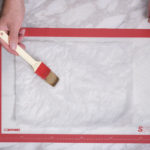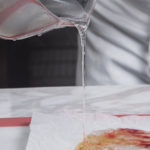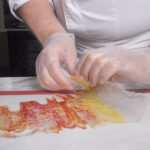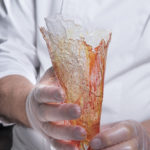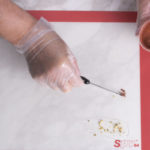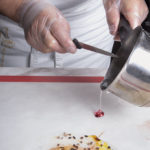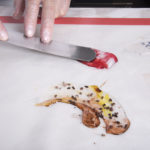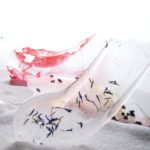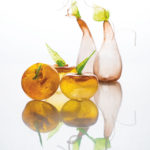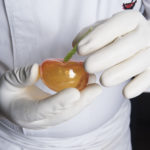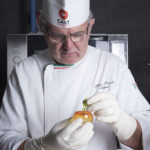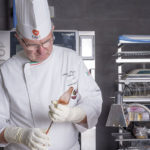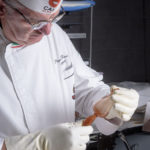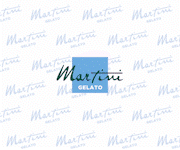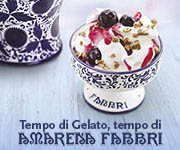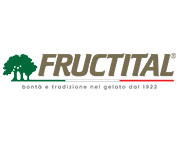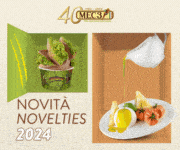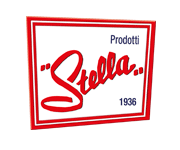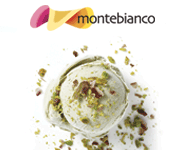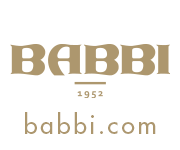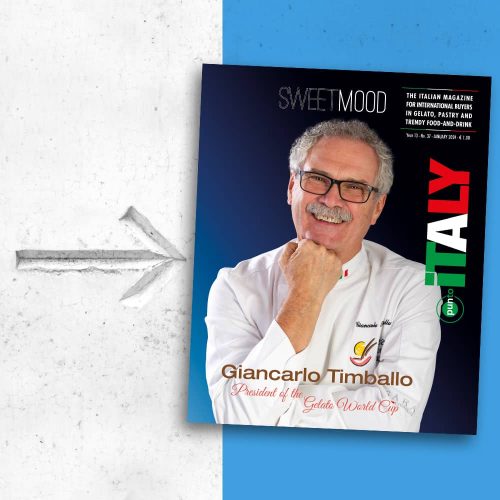Sugars

Reverse/Fusion – Chapter 1 “Technique bulletin board”
Sugar bollé
Method 1.
Melt isomalt (sugar obtained from the hydrogenation of sucrose) at 165°C, pour it on silicone baking paper. By making the layer as thin as possible you will have beautiful tiny bubbles. Isomalt is widely used when working with hot sugar because it remains remarkably malleable over a large range of temperatures, absolutely essential when shaping sugar. Using the same method you can color isomalt before pouring it onto the sheet. You can achieve a marbled effect by scattering spots of color on the paper and then pouring the isomalt on top. With this method, before the isomalt hardens you can make wavy shapes having an exquisite visual effect. It also keeps well even at temperatures below freezing.
Method 2.
Place a thin layer of raw isomalt on a silicone mat, then cover with another mat and bake at 160°C. Tiny bubbles will form, like glass with beautiful workmanship, with translucent effects if you add a bit of powdered gold or silver in small amounts (about 5 grams).
Flamed sugar
With the same recipe place a few drops of red and yellow color on a silicone mat and immediately pour a portion of sugar over them. Use spatula strokes from the bottom upwards, thinning the isomalt as much as possible. This will produce a flame effect. In addition, before it has cooled down completely you can sprinkle chopped pistachios, hazelnuts, and/or flower petals.
Blown sugar
The blown sugar technique recalls the extraordinary world of Murano glass. This method of working sugar can be used to create the most varied forms, like fruits, balls, and so much more. To use this technique with good results we suggest attending a course taught by a specialized instructor. In any case, here are some tips. The recipe is the same as for the pulled sugar.
Wearing the appropriate gloves, take the frosted or transparent sugar and form a ball of the desired size. Use your index finger to make a hole at the bottom. Push the blowpipe into this hole, and then tightly seal the hole by pressing the sugar around the blowpipe itself. Start blowing lightly, introducing air into the sugar so that it starts to expand. Shape the sugar while blowing. Slightly warm the blowpipe. Extract it from the sugar, making sure the hole remains open so gelato can be added.
Recent Blog Posts
 Medac and AIFA: Hip hip hooray for Charles!
Medac and AIFA: Hip hip hooray for Charles! Sigep 2024 - Carpigiani’s special events with a look at the “green” future of Gelato and pastry
Sigep 2024 - Carpigiani’s special events with a look at the “green” future of Gelato and pastry Maurizio Manzi, as Ambassador for AIG, at the Melbourne Italian Festa
Maurizio Manzi, as Ambassador for AIG, at the Melbourne Italian Festa Medac awarded with the EcoVadis gold medal
Medac awarded with the EcoVadis gold medal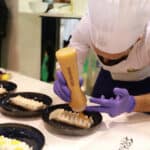 MIG Longarone and SIRHA Budapest: a new dynamic space for italian gelato
MIG Longarone and SIRHA Budapest: a new dynamic space for italian gelato Medac supports Alice Italian Food Academy
Medac supports Alice Italian Food Academy The Gelatissimo 2024 online ticket office is officially open.
The Gelatissimo 2024 online ticket office is officially open. Casa Optima Group looks for two exclusive agents
Casa Optima Group looks for two exclusive agents Gelatissimo 2024: here the first information
Gelatissimo 2024: here the first information Ci Gusta opens a new store into the “Il Mercato Eat&Meet” in Reggio Emilia
Ci Gusta opens a new store into the “Il Mercato Eat&Meet” in Reggio Emilia

